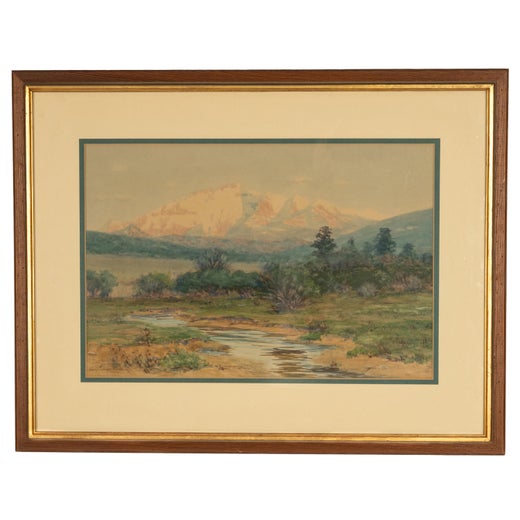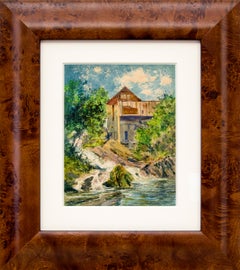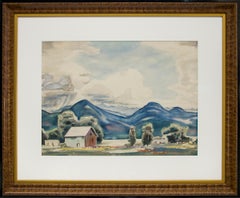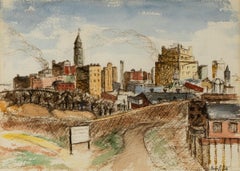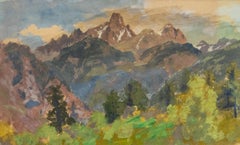Video Loading
Want more images or videos?
Request additional images or videos from the seller
1 of 11
Charles Partridge AdamsBlanca Peak, Sangre de Cristo Range, Colorado Mountain Landscape Painting Horsecirca 1915
circa 1915
Price:$2,000
$2,750List Price
About the Item
- Creator:Charles Partridge Adams (1858-1942, American)
- Creation Year:circa 1915
- Dimensions:Height: 9.5 in (24.13 cm)Width: 12.5 in (31.75 cm)Depth: 0.5 in (1.27 cm)
- Medium:
- Movement & Style:
- Period:
- Condition:
- Gallery Location:Denver, CO
- Reference Number:Seller: DCG-253531stDibs: LU2738274212
Charles Partridge Adams
Born in Franklin, Massachusetts, Charles Partridge Adams moved with his mother and two sisters to Denver, Colorado, in 1876 in an effort to cure the two girls who suffered from tuberculosis. In Denver, Adams found work at the Chain and Hardy Bookstore. He received his first, and only, art training from the owner's wife, Helen Chain. Mrs. Chain, a former pupil of George Inness, provided instruction and encouragement to the young artist and introduced him to other artists in the area including Alexander Phimister Proctor. Proctor and Adams developed a friendship and the pair embarked on a three-month camping trip in Egeria Park, Colorado. In addition to exploring, both artists did quite a bit of sketching on the trip. After their return to Denver, Adams and Proctor shared a studio for a short period of time before Proctor moved to New York. Adams remained in Denver and after a short stint as an art teacher he studied wood engraving with Major J.M. Bagley. He quickly abandoned the engraving for health reasons and began working in crayon. His business card read "Landscapes and Crayon Portraits" though he much preferred landscapes. The artist soon made a name for himself in Denver. He established a wealthy clientele that purchased a number of his paintings to decorate their homes and to give as Christmas gifts. In 1890, Adams married Alida Joslin Reynolds and the couple honeymooned in Estes Park, Colorado. That same year, he exhibited for the first time at the National Academy of Design. Three years later, the artist opened his first studio on Larimer Street in Denver. He began working in watercolor and had success in the new medium selling his paintings in stores in Colorado Springs, Pueblo, Kansas City, and Chicago. Also in 1893, Adams became a charter member of the Denver Artists Club. In 1905, the couples dream of living in Estes Park was realized when Adams completed construction on a home and studio there. Adams referred to the studio as "The Sketch Box" and the family spent summers there every year. Though Adams is best known for his Colorado landscapes, he also painted in Yellowstone, the Tetons, the Canadian Rockies, the New Mexican Desert, and California. In 1914, the couple sailed to Europe where they spent five months touring. Three years later, Charles suffered from a near-fatal illness. In 1920, Adams moved to California where he opened a studio first in Pasadena and later in Laguna Beach. He became a member of the Laguna Beach Artists Association and began painting marine subjects. ©David Cook Galleries, LLC
About the Seller
5.0
Gold Seller
Premium sellers maintaining a 4.3+ rating and 24-hour response times
Established in 1979
1stDibs seller since 2013
295 sales on 1stDibs
Typical response time: 4 hours
Authenticity Guarantee
In the unlikely event there’s an issue with an item’s authenticity, contact us within 1 year for a full refund. DetailsMoney-Back Guarantee
If your item is not as described, is damaged in transit, or does not arrive, contact us within 7 days for a full refund. Details24-Hour Cancellation
You have a 24-hour grace period in which to reconsider your purchase, with no questions asked.Vetted Professional Sellers
Our world-class sellers must adhere to strict standards for service and quality, maintaining the integrity of our listings.Price-Match Guarantee
If you find that a seller listed the same item for a lower price elsewhere, we’ll match it.Trusted Global Delivery
Our best-in-class carrier network provides specialized shipping options worldwide, including custom delivery.You May Also Like
Whimsical Watercolour of an Abstract Architectural Scene with Unique Details
Located in Cirencester, Gloucestershire
Abstract Architectural Scene
original watercolour painting on artist paper
by Marjorie Schiele (1913-2008) *see notes below
piece of paper is 14 x 10 inches
In good condition
provena...
Category
Early 20th Century American Impressionist Landscape Paintings
Materials
Watercolor
$209 Sale Price
20% Off
H 14 in W 10 in
A Colourful Garden Scene Captured in Watercolour French Mid 20th Century
Located in Cirencester, Gloucestershire
A Colorful Garden Scene
original watercolour painting on artist paper
signed by Marjorie Schiele (1913-2008) *see notes below
piece of paper is 9.5 x 12.5 inches
In good condition
p...
Category
Early 20th Century American Impressionist Landscape Paintings
Materials
Watercolor
Marjorie Schiele (1913-2008)A Colourful Garden Scene Captured in Watercolour French Mid 20th Century
$286 Sale Price
20% Off
H 9.5 in W 12.5 in
Bright Idyllic Watercolor Landscape of a Lakeside Village with Canoeists
Located in Cirencester, Gloucestershire
Idyllic Watercolor Landscape
original watercolour painting on artist paper
signed by Marjorie Schiele (1913-2008) *see notes below
piece of paper is 9.5 x 12 inches
In good condition...
Category
Early 20th Century American Impressionist Landscape Paintings
Materials
Watercolor
Marjorie Schiele (1913-2008)Bright Idyllic Watercolor Landscape of a Lakeside Village with Canoeists
$248 Sale Price
20% Off
H 9.5 in W 12 in
Vibrant Watercolor Landscape of a Sunlit Forest and Rolling Hills
Located in Cirencester, Gloucestershire
Vibrant Watercolor Landscape
original watercolour painting on artist paper
signed by Marjorie Schiele (1913-2008) *see notes below
piece of paper is 9.5 x 12.5 inches
In good conditi...
Category
Early 20th Century American Impressionist Landscape Paintings
Materials
Watercolor
$286 Sale Price
20% Off
H 9.5 in W 12.5 in
Canyon Country, 16x20, watercolor landscape, framed
By Lu Haskew
Located in Loveland, CO
Canyon Country by Lu Haskew
Pastel 16x20" image size
Additional images available upon request.
Landscape view of the Grand Canyon
ABOUT THE ARTIST: Lu Haskew 1921-2009
"Life is good to me. Being able to go to my studio five days weekly and paint for several hours, living in a supportive community, having family and friends who encourage me--all have contributed to helping me become an artist. Being fortunate to study with some of the artists I admire has kept me painting from the garden, people and my favorite things. With the support of galleries, teaching and doing demos, how could I do anything else? My goal is to try to be the best I can be by always being a student, looking for new ideas and stretching my horizons."
Upon retirement from a 33-year teaching career, Lu rented a studio in Loveland and began concentrating on
her oil and watercolor painting. Learning from artists she had followed and admired throughout the years
her painting became a full time career. Since 1992, she has studied with renowned painters Richard
Schmid, Clyde Aspevig, Joyce Pike, and others at the Scottsdale Art...
Category
1990s American Impressionist Landscape Paintings
Materials
Watercolor
$480 Sale Price
23% Off
H 24 in W 28 in D 2 in
"Monhegan Island, Maine, " Edward Dufner, American Impressionism Landscape View
By Edward Dufner
Located in New York, NY
Edward Dufner (1872 - 1957)
Monhegan Island, Maine
Watercolor on paper
Sight 16 x 20 inches
Signed lower right
With a long-time career as an art teacher and painter of both 'light' and 'dark', Edward Dufner was one of the first students of the Buffalo Fine Arts Academy to earn an Albright Scholarship to study painting in New York. In Buffalo, he had exchanged odd job work for drawing lessons from architect Charles Sumner. He also earned money as an illustrator of a German-language newspaper, and in 1890 took lessons from George Bridgman at the Buffalo Fine Arts Academy.
In 1893, using his scholarship, Dufner moved to Manhattan and enrolled at the Art Students League where he studied with Henry Siddons Mowbray, figure painter and muralist. He also did illustration work for Life, Harper's and Scribner's magazines.
Five years later, in 1898, Dufner went to Paris where he studied at the Academy Julian with Jean-Paul Laurens and privately with James McNeill Whistler. Verification of this relationship, which has been debated by art scholars, comes from researcher Nancy Turk who located at the Smithsonian Institution two 1927 interviews given by Dufner. Turk wrote that Dufner "talks in detail about Whistler, about how he prepared his canvasas and about numerous pieces he painted. . . A great read, the interview puts to bed" the ongoing confusion about whether or not he studied with Whistler.
During his time in France, Dufner summered in the south at Le Pouleu with artists Richard Emil Miller...
Category
Early 20th Century American Impressionist Landscape Drawings and Waterco...
Materials
Paper, Watercolor
"Alpi Apuane, Italy" american impressionist watercolor painting of Swiss Alps
By Nelson H. White
Located in Sag Harbor, NY
Painted from life, the Swiss Alps as viewed from Italy. Framed in a thick grey wooden frame.
Dimensions framed: 12.5 x 19.25 inches
Nelson H. White was born in New London, Connectic...
Category
21st Century and Contemporary American Impressionist Landscape Paintings
Materials
Watercolor
"Canal at Indian Mound Road" RARE Ben Fenske Gouache work on paper black & white
By Ben Fenske
Located in Sag Harbor, NY
Painted during the 2015 Winter Equestrian Festival in Wellington, Florida. A black and white depiction of a canal, is barely recognizable, due to Fenske's wild brushstrokes and lack...
Category
21st Century and Contemporary American Impressionist Landscape Paintings
Materials
Paper, Gouache
"Viareggio, Italy" Impressionist, Landscape, Watercolor painting, framed
By Nelson H. White
Located in Sag Harbor, NY
"Viareggio, Italy" is an impressionist watercolor painting of a beautiful seaside city just outside the hills of tuscany in Italy.
Nelson H. White was born in New London, Connecticut in 1932. White has been surrounded by art and artists from the time he was born. He received his earliest art instruction from his grandfather, Henry Cooke White (1861-1952) and his father Nelson Cooke White (1900-1989), both important American artists. The family lived in Waterford, Connecticut and the elder White had been an early member of the art colony in Old Lyme, Connecticut. Known for his paintings of the Connecticut landscape and shoreline, Henry Cooke White became a teacher to his son, Nelson Cooke White. Living with his parents at the Florence Griswold house in Old Lyme, he met some of the most important and influential artists of the day, Childe Hassam, Will Howe Foote and Harry Hoffman.
Later, Nelson White's father began to take his family to summer on Shelter Island and became friendly with many of the artists of the Peconic colony such as Irving Wiles, an important American impressionist. After graduating from the Tabor Academy in Marion, Massachusetts in 1951, Nelson H. White began to study at Mitchell College in Connecticut but left to pursue studies in the violin, musical theory and composition. At this time, he began to spend more time studying art with his father and grandfather. By 1955, Nelson H. White had decided to devote himself to a career as a painter and traveled to Florence, Italy to become an apprentice to Pietro Annigoni, the world-renowned Florentine master. Within two years, the young White had won two awards for his work. While in Florence he also studied with the great Italian teacher, Nerina Simi. Today, White divides his time between the United States and Florence.
Although he has received instruction from some very important artists, White's work is highly individual. He paints with great spirit. Upon seeing his work one quickly senses White’s great love for nature and the outdoors. Through his eyes we are able to view and interpret nature in an intimate manner. Whether Nelson H. White is painting the Connecticut shore...
Category
21st Century and Contemporary American Impressionist Landscape Drawings ...
Materials
Watercolor
Island in the San Francisco Bay, Mid Century Landscape by Alexander Nepote
By Alexander Nepote
Located in Soquel, CA
Mid Century Island in the San Francisco Bay Landscape by Alexander Nepote
Lovely late 1930's Impressionist watercolor of a Bay Area island by listed California artist Alexander Nepo...
Category
1930s American Impressionist Landscape Paintings
Materials
Paper, Watercolor
$1,397 Sale Price
35% Off
H 24 in W 30 in D 0.25 in
More From This Seller
View AllCharles Partridge Adams Watercolor – New Hampshire Mill Scene, c. 1900
By Charles Partridge Adams
Located in Denver, CO
This elegant original watercolor painting by renowned landscape artist Charles Partridge Adams (1858–1942) was created circa 1900 and captures a peaceful New England scene near Plain...
Category
20th Century American Impressionist Landscape Drawings and Watercolors
Materials
Watercolor
Sangre de Cristo Mountains Watercolor Landscape Painting, Southern Colorado
By Alfred Wands
Located in Denver, CO
This original watercolor painting by Alfred Wands (1904-1998) captures the breathtaking beauty of the Sangre de Cristo Mountain range in Sou...
Category
20th Century American Impressionist Landscape Paintings
Materials
Watercolor
1950s Denver Skyline Painting – Graphite & Watercolor Colorado Cityscape Art
Located in Denver, CO
A captivating midcentury cityscape titled "Denver Skyline", this original 1950s watercolor and graphite painting offers a rare industrial-era view of lower downtown Denver, Colorado....
Category
1950s American Impressionist Landscape Paintings
Materials
Watercolor, Graphite
Charles Partridge Adams, Colorado Landscape Gouache, 20th-Century Plein Air Art
By Charles Partridge Adams
Located in Denver, CO
This original circa 1910s plein air field study by celebrated Colorado landscape painter Charles Partridge Adams (1858–1942) beautifully captures the tranquil majesty of the Rocky Mo...
Category
1910s American Impressionist Landscape Paintings
Materials
Gouache
Charles Partridge Adams California Coastal Watercolor, American Impressionist
By Charles Partridge Adams
Located in Denver, CO
This exquisite California coastal watercolor by American Impressionist Charles Partridge Adams (1858–1942) captures the serene beauty of the shoreline in vibrant hues of blue, green,...
Category
1920s American Impressionist Landscape Paintings
Materials
Watercolor
1940s Western Landscape of Silver Plume, Colorado, Framed Oil Pastel Drawing
By Elsie Haddon Haynes
Located in Denver, CO
A captivating early 20th-century Western mountain landscape by Colorado artist Elsie Haddon Haynes (1884–1963), this original oil pastel drawing captures the charming town of Silver Plume...
Category
1930s American Impressionist Landscape Drawings and Watercolors
Materials
Oil Pastel
Recently Viewed
View AllMore Ways To Browse
5 X 9 Painting
Alexander Phimister Proctor
Tropical Island Art
Vintage Christmas Village
Vintage Hay Wagon
Vintage Pastel Landscape
William Ship Painting
Wolf Kahn Pastels
Wyoming Oil Painting
Yvette Bossiere
1910s Oil Painting
Adriaen Van De Velde
Agnes Reeve
Aldro Hibbard Thompson
Alfred De Breanski Snr
Alicia Dubnyckyj
Amalfi Coast Oil Painting
Ameglio Merio
